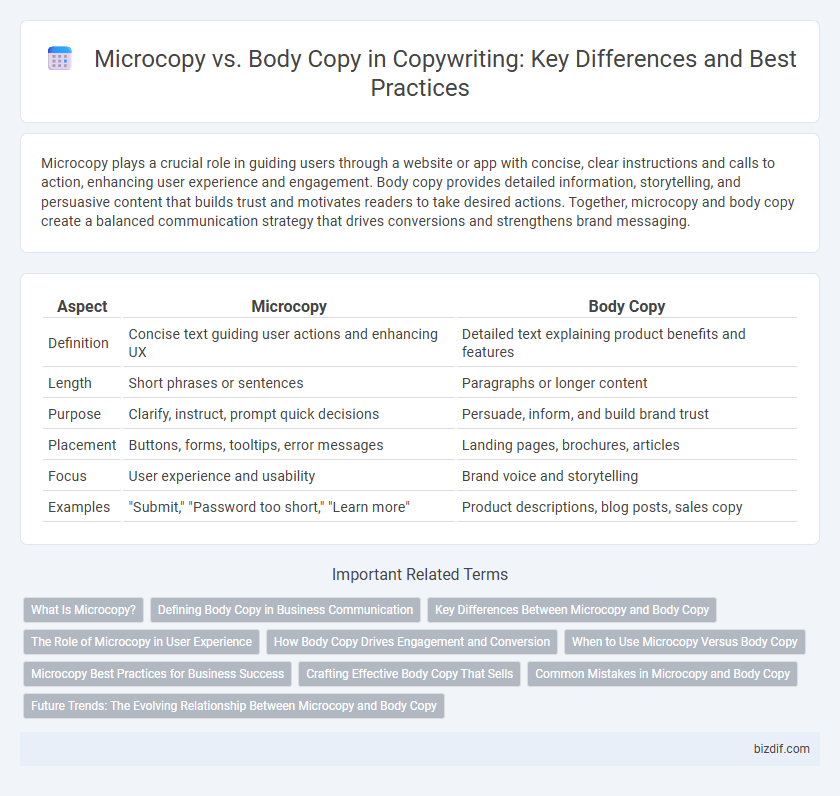Microcopy plays a crucial role in guiding users through a website or app with concise, clear instructions and calls to action, enhancing user experience and engagement. Body copy provides detailed information, storytelling, and persuasive content that builds trust and motivates readers to take desired actions. Together, microcopy and body copy create a balanced communication strategy that drives conversions and strengthens brand messaging.
Table of Comparison
| Aspect | Microcopy | Body Copy |
|---|---|---|
| Definition | Concise text guiding user actions and enhancing UX | Detailed text explaining product benefits and features |
| Length | Short phrases or sentences | Paragraphs or longer content |
| Purpose | Clarify, instruct, prompt quick decisions | Persuade, inform, and build brand trust |
| Placement | Buttons, forms, tooltips, error messages | Landing pages, brochures, articles |
| Focus | User experience and usability | Brand voice and storytelling |
| Examples | "Submit," "Password too short," "Learn more" | Product descriptions, blog posts, sales copy |
What Is Microcopy?
Microcopy consists of small, targeted text elements such as buttons, error messages, and labels designed to guide users through digital interfaces effortlessly. It enhances user experience by providing clear, concise instructions or reassurance at critical interaction points. Effective microcopy reduces friction, improves usability, and supports conversion by addressing user needs with precise language.
Defining Body Copy in Business Communication
Body copy in business communication encompasses the main content that delivers detailed information, explains products or services, and persuades the audience through clear, concise language. Unlike microcopy, which consists of brief, functional text like buttons or error messages, body copy forms the core narrative that supports brand messaging and drives conversions. Effective body copy balances informative content with engaging storytelling to enhance reader understanding and encourage action.
Key Differences Between Microcopy and Body Copy
Microcopy consists of brief, context-specific text like buttons, error messages, and tooltips that guide users through digital interfaces, enhancing user experience and clarity. Body copy refers to longer, more detailed text sections such as articles, blog posts, and sales pages designed to inform, persuade, or engage readers at depth. The key differences lie in length, purpose, and placement: microcopy is concise and action-oriented, while body copy provides comprehensive information and storytelling.
The Role of Microcopy in User Experience
Microcopy plays a crucial role in enhancing user experience by providing clear, concise guidance that helps users navigate digital interfaces effortlessly. Unlike body copy, which delivers detailed information and storytelling, microcopy focuses on clarity and brevity to reduce friction and prevent errors. Effective microcopy improves usability and user satisfaction by making interactions intuitive and minimizing confusion.
How Body Copy Drives Engagement and Conversion
Body copy plays a crucial role in driving engagement and conversion by providing detailed information that addresses customer pain points and highlights product benefits. Effective body copy uses persuasive language and storytelling techniques to build trust and motivate readers to take action. Optimized body copy enhances SEO visibility, attracting targeted traffic and increasing the likelihood of conversion.
When to Use Microcopy Versus Body Copy
Microcopy should be used for guiding users through specific actions, such as button labels, error messages, and form instructions, where clarity and brevity are essential. Body copy is ideal for providing detailed information, storytelling, or persuasive content that requires a deeper explanation to engage and inform the reader. Choosing microcopy or body copy depends on the communication goal: microcopy enhances user experience with concise, actionable text, while body copy builds context and connection through elaborate messaging.
Microcopy Best Practices for Business Success
Effective microcopy enhances user experience by providing clear, concise instructions and prompts that guide users seamlessly through a website or app. Prioritizing clarity, relevance, and tone consistency in microcopy boosts engagement, reduces errors, and increases conversion rates, making it a critical element for business success. Strategic placement of microcopy in call-to-action buttons, error messages, and form fields ensures users receive immediate, helpful guidance, driving better outcomes and customer satisfaction.
Crafting Effective Body Copy That Sells
Crafting effective body copy that sells requires a deep understanding of audience needs and clear communication of product benefits. Body copy should leverage persuasive language and emotional triggers to build trust and encourage conversions. Unlike microcopy's brief guidance, body copy allows for detailed storytelling that highlights features, value propositions, and calls to action, ultimately driving sales and engagement.
Common Mistakes in Microcopy and Body Copy
Common mistakes in microcopy include using vague language that confuses users, neglecting clear calls to action, and ignoring the importance of tone that aligns with the brand voice. In body copy, errors often involve lengthy, unfocused content that overwhelms readers, lack of keyword integration for SEO, and failing to address the audience's needs effectively. Both types of copy require precision and clarity to optimize user engagement and conversion rates.
Future Trends: The Evolving Relationship Between Microcopy and Body Copy
Future trends in copywriting reveal an increasing integration between microcopy and body copy, driven by AI-powered personalization and voice search optimization. Microcopy's role in enhancing user experience through concise, context-aware prompts complements body copy's in-depth storytelling and brand messaging. Emerging technologies are pushing these two elements to work in tandem, ensuring seamless communication that adapts dynamically to consumer behavior and platform-specific interactions.
Microcopy vs Body Copy Infographic

 bizdif.com
bizdif.com